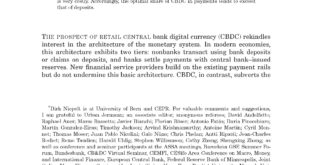Journal of Finance. HTML (local copy). Abstract: We analyze the role of retail central bank digital currency (CBDC) and reserves when banks exert deposit market power and liquidity transformation entails externalities. Optimal monetary architecture minimizes the social costs of liquidity provision and optimal monetary policy follows modified Friedman rules. Interest rates on reserves and CBDC should differ. Calibrations robustly suggest that CBDC provides liquidity more efficiently than...
Read More »“Money and Banking with Reserves and CBDC,” CEPR, 2023
CEPR Discussion Paper 18444, September 2023. HTML (local copy). Abstract: We analyze the role of retail central bank digital currency (CBDC) and reserves when banks exert deposit market power and liquidity transformation entails externalities. Optimal monetary architecture minimizes the social costs of liquidity provision and optimal monetary policy follows modified Friedman (1969) rules. Interest rates on reserves and CBDC should differ. Calibrations robustly suggest that CBDC provides...
Read More »“Money and Banking with Reserves and CBDC,” UniBe, 2022
UniBe Discussion Paper 22-12, October 2022. PDF. We analyze retail central bank digital currency (CBDC) in a two-tier monetary system with bank deposit market power and externalities from liquidity transformation. Resource costs of liquidity provision determine the optimal monetary architecture and modified Friedman (1969) rules the optimal monetary policy. Optimal interest rates on reserves and CBDC differ. A calibration for the U.S. suggests a weak case for CBDC in the baseline but a...
Read More »“Monetary Policy with Reserves and CBDC: Optimality, Equivalence, and Politics,” CEPR, 2020
CEPR Discussion Paper 15457, November 2020. PDF (local copy). We analyze policy in a two-tiered monetary system. Noncompetitive banks issue deposits while the central bank issues reserves and a retail CBDC. Monies differ with respect to operating costs and liquidity. We map the framework into a baseline business cycle model with “pseudo wedges” and derive optimal policy rules: Spreads satisfy modified Friedman rules and deposits must be taxed or subsidized. We generalize the...
Read More » Swiss Economicblogs.org
Swiss Economicblogs.org

